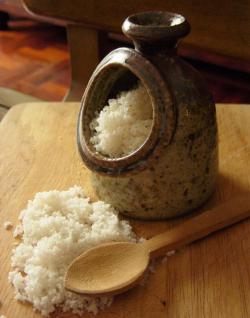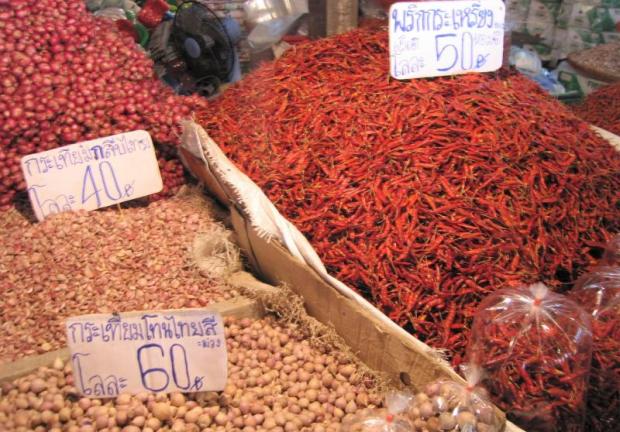Most people who like to cook will also like to have their kitchen spacious, well-lit, airy and filled with all necessary utensils, a big fridge and a big cupboard for all those seasonings.
Seasonings are crucial because they must always be ready and fully stocked. Thai food does use a diverse range of seasonings.

Different spices.
This time, let's introduce some must-have seasonings, what kind of food they should be used for, and where to buy them. The places one can find various seasonings are also unique. If it's Chinese food, seasonings can be found at Leng Buai Eia market or Soi Issaranuphap in Yaowarat, and Samyarn market in Chula Soi 9. If it's Thai food, head to Klong Toey market and general fresh markets.
Necessary seasonings include soy sauce, soybean paste and oyster sauce, which can be found mostly at Leng Buai Eia market and Samyarn market. For soy sauce, it's recommended that buyers seek from small family-owned factories like Nok Krarian (crane), Mang Po (dragonfly), Nok Krayang (egret) and Khon Pai Ruea (man rowing a boat) brands. There are also brands from nearby provinces such as Suea (tiger) from Ratchaburi and Ruea Bai (sail boat) from Samut Prakan. These brands are old. They make tasty sauces, but in small amounts. People who cook used to know them very well. Most importantly, they aren't available in supermarkets or 7-Elevens.
These two markets also sell oyster sauce from China. There are two kinds, made from abalone and scallop. These sauces aren't too salty. Their colours aren't too dark. There are strands of meat in the sauce too. Additionally, there is fermented bean curd wrapped with bamboo leaf and pickled cabbage in black clay pot.
An important thing to buy is powered galangal, to be put specifically in khao tom pla (boiled rice soup with fish). Powdered galangal made in Thailand isn't bottled, but sold according to weight. Aside from these two markets, small grocery shops in Chon Buri may sell it, but not usually supermarkets.
Other things to buy include dried halibut and dried scallop from China. They can be made into Chinese-style soup. At Leng Buai Eia market, there is also Hand-brand pepper, both black and white, that comes in grain and fine-powder versions. Its quality is trustworthy.

Sugar from Isan sugarcane. If you have a chance, buy it.
For white pepper that is generally sold, you have to be careful. If its colour is too white, it could have undergone some bleach in the manufacturing process to turn black pepper white. That bleaching solution is often used to soak peanut and yam to get rid of natural stains on its skin to make it look more appealing, without knowing how dangerous it is.
Thai seasonings at the Klong Toey fresh market and general markets are kapi (shrimp paste). Every household has it. In Bangkok, people will be familiar with shrimp paste from Klong Khon, Samut Songkhram and Ban Pae in Rayong.

Salt from the best fleur de sel.
Shrimp paste from Klong Khon is the most famous one. The entire locality makes shrimp paste for a living, and they've been doing it for a long time. The shrimp paste would be sundried for many days and ground until it results in a fine texture, dark colour and salty taste.
There are other sources for shrimp paste along the Gulf of Thailand, such as Prachuap Khiri Khan, Chumphon, Surat Thani and Nakhon Si Thammarat. On the Andaman Sea side, there are Krabi, Phangnga, Ranong and Trang. The fermentation method and salt ratio are different. Many carry a good fragrance. Its colour is not too dark, its taste not too salty.
If you're used to any particular type of shrimp paste, and use it in the right amounts, the food will taste as it always has. But if you change the type of shrimp paste, you have to know its level of saltiness, colour and smell. The problem with getting shrimp paste from afar is, if you get hooked on to it, it's more difficult to buy compared to those widely available in Bangkok.
Tamarind paste is also necessary. Thai food uses it all the time. Normally, it is sold in fresh markets. In choosing tamarind paste, the fresh ones will look a shade of yellow and orange. Darker ones tend to be old. To squeeze just enough tamarind juice out of it each time can be difficult. The best way is to stock it up. Use warm water because it's easier. Once you're done squeezing the load, you can divide the portion into smaller plastic bags and store them in the freezer.
Coconut and palm sugar come in two forms: solid (known as namtarn peuk) and liquid (known as namtarn peep). The solid may be a little more complicated to use. But be careful of the liquid kind. Granulated sugar is cheaper, and so some merchants have taken advantage of their customers by mixing the regular sugar with water and heating it up until it thickens and resembles namtarn peep. This sells for a higher price compared to normal, granulated sugar. The colour of fake namtarn peep is evenly the same colour throughout.

Shrimp paste sold in typical fresh markets.
If it's genuine namtarn peep, its brown colour will come in a mix of shades. Farmers who make this sugar will churn it many times a day. Each time, the colour will be different. When poured into the same container, it won't look consistent.
For fish sauce, we can never be sure of the process of those that come from manufacturing factories and are sold widely at supermarkets and fresh markets. They produce so much at such a low price, which contradicts the time it takes for the fermentation and producing such large amounts. Getting fish sauce from a small, family-owned enterprise is more trustworthy, but also more complicated to find. If you get a chance to travel into regions where they sell locally made fish sauce, it's worth buying a bottle back. There is Wang Tai fish sauce from Kuiburi district, Prachuap Kiri Khan; Samchai's from Potharam, Ratchaburi; Ded Duang's from Kong Krailas, Sukhothai, which is made from pla soi. Ded Duang's can also mail their fish sauce. Place your order at 081-973-2666.
If you can get quality seasonings, you feel confident about your cooking. It's also a way to help manufacturers directly.

Tamarind paste. If it's as dark as the one in the picture, it's an old one.

Ded Duang's fish sauce from Sukhothai.

